Have you ever wondered if throttle issues are more common than most riders admit? It's a reality that many motorcycle enthusiasts face various throttle-related problems, often without realizing their impact. From sticking cables to software glitches, these issues can greatly affect your ride. Understanding these common throttle issues could be the key to enhancing your motorcycle's performance and safety. So, what are the most prevalent problems you should watch out for, and how can you address them effectively?
Key Takeaways
- Throttle response delays can frustrate riders, often caused by sluggish throttle bodies or fuel delivery issues.
- Sticking throttle cables result from dirt buildup, corrosion, or improper routing, leading to unresponsive throttle behavior.
- Faulty throttle position sensors can cause stuttering acceleration and should be checked with diagnostic tools for error codes.
- Inconsistent idle speeds may indicate fuel delivery problems or electrical malfunctions, affecting overall motorcycle performance.
Throttle Response Delays
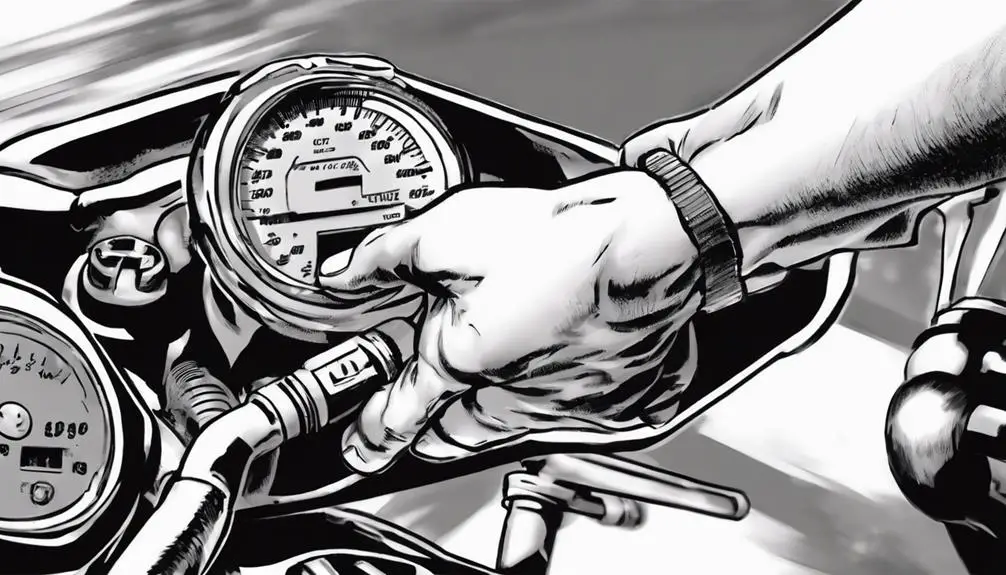
Throttle response delays can frustrate riders when they twist the grip and expect immediate acceleration. You crave the freedom of the open road, where every twist and turn ignites a surge of adrenaline. When your bike doesn't respond as quickly as you want, it can feel like a chain holding you back.
These delays can stem from various issues, including a sluggish throttle body, fuel delivery problems, or even electronic glitches in modern bikes.
You don't have to let these delays dictate your ride. Start by checking your throttle assembly for any signs of wear or dirt that might be impeding smooth operation. Clean or replace components as needed.
Next, verify your fuel system is in prime condition; clean filters and inspect fuel injectors to guarantee peak flow. If you're riding a newer model, consider updating your bike's software or consulting a mechanic to recalibrate the throttle response.
Sticking Throttle Cables
If you notice your throttle isn't responding smoothly, it might be due to sticking cables.
Understanding the causes and symptoms can help you address the issue before it gets worse.
Plus, regular maintenance can prevent sticking cables from becoming a recurring problem.
Causes of Sticking Cables
Several factors can lead to sticking throttle cables, including dirt buildup, corrosion, or improper routing.
When you ride, dirt and grime can accumulate in the cable housing, restricting movement and causing frustration. If you haven't cleaned your bike regularly, this accumulation might surprise you.
Corrosion is another major culprit. Over time, moisture can seep into the cables, leading to rust and deterioration. This can create rough spots that snag the cable, making your throttle feel sluggish. You might think it's just a minor inconvenience, but it can hinder your freedom on the road.
Improper routing of cables also plays a significant role. If the cables are twisted, pinched, or bent at sharp angles, they can bind up and make it hard to control your throttle. It's vital to inspect the routing regularly and guarantee everything runs smoothly.
Lastly, wear and tear is inevitable. Over time, cables can fray or break down, leading to sticking issues. Regular maintenance and inspections can help you catch these problems early, allowing you to enjoy the open road without unwanted restrictions.
Stay vigilant to keep your ride liberating!
Symptoms to Watch For
Recognizing the symptoms of sticking throttle cables can help you address issues before they escalate, ensuring a smoother ride. One of the first signs you might notice is a throttle that feels unresponsive or sluggish when you twist the grip. You could also experience sudden surges in power, making the bike feel jumpy or difficult to control.
As you ride, listen for unusual sounds, like a clicking or grinding noise coming from the throttle assembly. This can indicate that the cable isn't moving freely. Check your throttle return; if it doesn't spring back to the idle position quickly, that's another red flag.
You may also notice that your bike stalls or struggles to maintain speed, which can be frustrating and dangerous. Pay attention to any erratic engine behavior, as this can signal that the throttle isn't functioning properly.
Ultimately, staying aware of these symptoms can empower you to take charge of your motorcycle's performance, allowing you to enjoy the freedom of the open road without fear of throttle issues. Your ride deserves nothing less than smooth handling and reliable performance.
Maintenance and Prevention Tips
Regular maintenance is key to preventing sticking throttle cables and guaranteeing your motorcycle runs smoothly.
Start by inspecting your throttle cables regularly. Look for signs of wear, fraying, or kinks that could hinder their movement. If you notice any issues, replace the cables promptly to avoid bigger problems down the road.
Lubricate the cables using a high-quality cable lube. This'll help them glide freely, reducing the risk of sticking. Don't forget to clean the cable housing, as dirt and grime can build up and cause friction.
Make it a habit to check your throttle grip for smooth operation, too; if it feels sticky, it's time to address it.
Pay attention to the routing of your cables. Verify they're not too tight or pinched, as this can lead to sticking.
Faulty Throttle Position Sensors
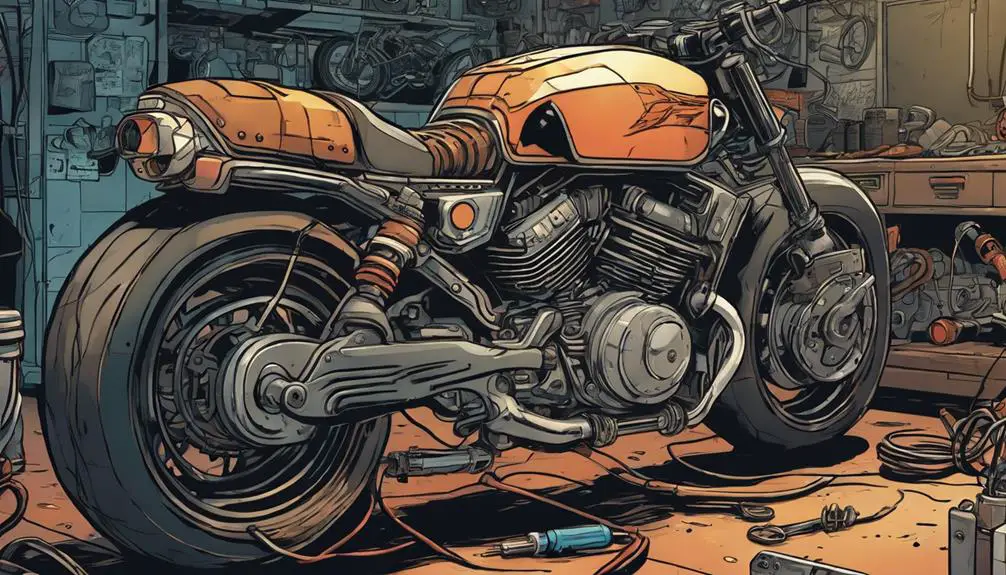
If your motorcycle's throttle isn't responding as expected, a faulty throttle position sensor might be the culprit. This sensor plays an important role in communicating your throttle's position to the engine control unit (ECU). When it malfunctions, you may experience stuttering acceleration or even complete throttle failure, leaving you feeling trapped instead of free on the open road.
To identify a faulty sensor, start by checking for error codes using a diagnostic tool. If you find one related to the throttle position, it's time to take action. Sometimes, the wiring or connectors are the issue, so inspect them for damage or corrosion. If everything looks fine, the sensor may need replacement.
Don't underestimate the impact of a properly functioning throttle position sensor; it's vital for achieving that exhilarating ride you crave. Riding should be about liberation, not frustration. Once you resolve the issue, you'll feel the difference as your bike responds as it should, releasing the power beneath you.
Embrace the freedom of the road by ensuring your throttle system is in peak condition. Your motorcycle deserves it, and so do you!
Inconsistent Idle Speeds
When you're riding, inconsistent idle speeds can be frustrating and concerning. You might notice your motorcycle's engine revving up and down unexpectedly, which can signal underlying issues.
Let's look at the common causes, symptoms to watch for, and the solutions to get your bike running smoothly again.
Causes of Inconsistent Idling
Inconsistent idling in motorcycles often stems from various factors, including fuel delivery issues, air intake problems, and electrical system malfunctions.
If your bike's fuel system isn't delivering the right amount of gasoline to the engine, you might experience erratic idling. Clogged fuel filters or failing fuel pumps can disrupt the flow, leaving you frustrated and yearning for smooth rides.
Air intake problems, like dirty or damaged air filters, can also lead to inconsistent idling. When the engine doesn't receive the proper air-fuel mixture, it struggles to maintain a steady idle.
Additionally, your motorcycle's electrical system plays an essential role in its overall performance. A weak battery, faulty spark plugs, or issues with the ignition system can cause irregular engine behavior. If you're feeling the freedom of the open road, you want a bike that responds seamlessly to your commands.
Understanding these causes lets you tackle the root of the problem, freeing you from the constraints of inconsistent idling. By addressing these issues, you'll reconnect with the exhilarating ride that comes with a well-tuned motorcycle.
Symptoms to Identify
Recognizing the symptoms of inconsistent idle speeds can help you pinpoint issues before they escalate into major problems. If your motorcycle's engine revs up and down unexpectedly when idling, that's a clear sign something's off. You might notice your bike hesitating or stalling, especially when you come to a stop. This erratic behavior can steal your sense of freedom on the road, leaving you feeling anxious about your ride.
Pay attention to any unusual noises as well. If you hear sputtering, popping, or a rough engine sound, these can be indicators of an idle speed problem. You may also detect a change in your throttle response; if your bike feels sluggish or overly sensitive, it's worth investigating further.
Vibrations can also be a telltale sign. A smooth ride is what you crave, so if you feel excessive shaking at idle, it's time to take action.
Solutions and Repairs
Addressing inconsistent idle speeds requires a systematic approach to diagnose and fix the underlying issues.
First, check your air filter; a dirty or clogged filter can restrict airflow, causing erratic idling. Clean or replace it if necessary.
Next, inspect your throttle body and idle air control valve. These components can become dirty or malfunction, leading to unstable engine behavior. You might want to clean them with appropriate solutions or replace them if they're too far gone.
Don't ignore the fuel system either. Verify your fuel injectors are clean and functioning properly. If you suspect they're clogged, consider using a fuel injector cleaner or having them professionally serviced.
Additionally, verify that your spark plugs are in good condition; worn plugs can disrupt the ignition process and lead to uneven idling.
Lastly, make sure your motorcycle's electrical connections are secure. Loose or corroded wires can send mixed signals to the engine control unit, creating a chaotic idle.
Air Intake Blockages
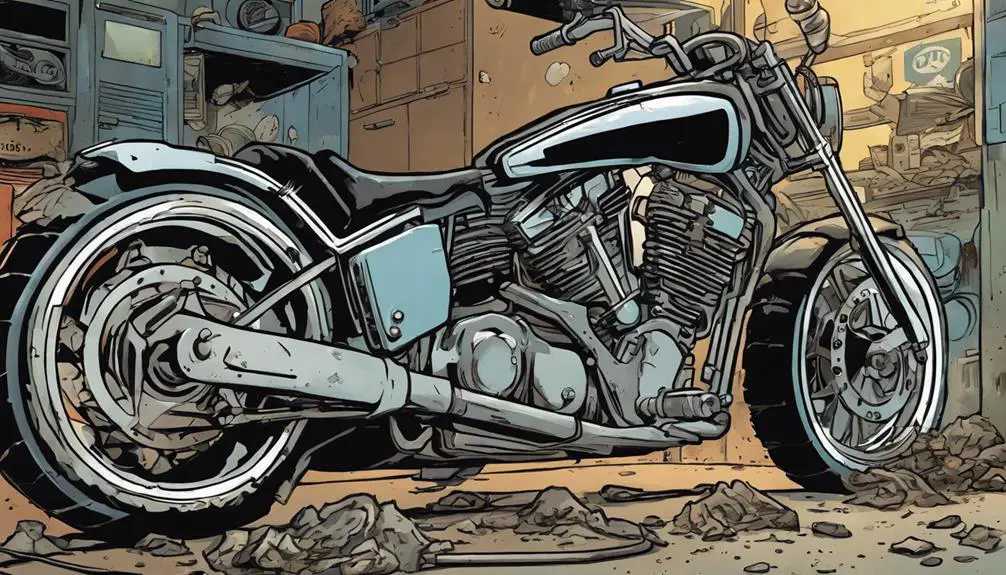
Air intake blockages can greatly affect your motorcycle's performance, causing throttle issues that make riding frustrating. When air flow is restricted, your engine can't breathe, leading to sluggish acceleration and reduced power. You might notice that twisting the throttle feels unresponsive, robbing you of the freedom that riding should bring.
To tackle this issue, start by inspecting your air filter. A dirty or clogged filter can create a significant barrier, choking your engine's performance. If you see dirt, debris, or oil buildup, it's time to clean or replace it. Don't forget to check the intake ducts and hoses for any obstructions or leaks. Even a small blockage can disrupt the balance your bike needs to run smoothly.
Additionally, keep an eye on the air intake location. If you ride in dusty or wet environments, those elements can quickly lead to blockages. Regular maintenance is key to ensuring your motorcycle remains a liberating force in your life.
Fuel Delivery Problems
Fuel delivery problems can seriously hinder your motorcycle's performance, making it hard to maintain consistent power and responsiveness. If your bike struggles to accelerate or feels sluggish, the culprit might be a clogged fuel filter or a failing fuel pump. You need to guarantee that fuel flows freely to the engine, as any obstruction can rob you of that exhilarating ride you crave.
Check the fuel lines for leaks or kinks—they can disrupt the smooth delivery of fuel. If your motorcycle has a carburetor, it could be gummed up with old fuel. Cleaning the carburetor can restore your bike's energy. In fuel-injected bikes, a malfunctioning sensor can cause erratic fuel delivery; consider getting a diagnostic check.
Don't forget about your fuel itself. Running low-quality fuel or letting the tank sit empty can lead to sediment buildup, which impacts performance. Regular maintenance of the fuel system guarantees your motorcycle's engine breathes deeply and runs efficiently.
Electrical Connection Issues
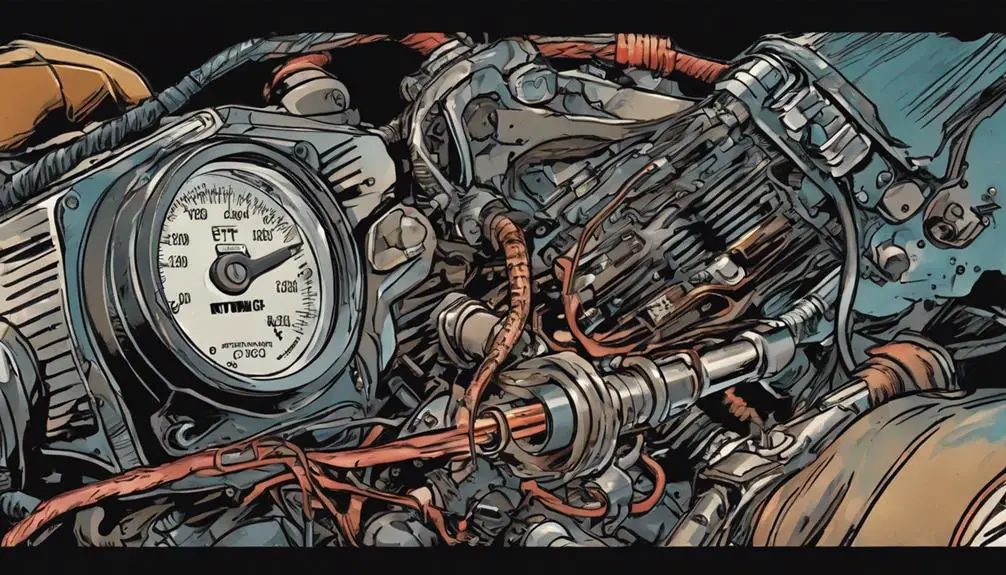
While fuel delivery problems can affect power and responsiveness, electrical connection issues can equally disrupt your motorcycle's performance and reliability. You might find that your throttle feels unresponsive or inconsistent, leaving you frustrated and yearning for that exhilarating ride. The heart of your bike's electrical system lies in its connections, so loose, corroded, or damaged wires can lead to serious throttle issues.
Start by checking the wiring harness. If you spot any frayed wires or corrosion, it's time to take action. Clean and secure those connections—every little detail matters.
Don't forget to inspect the battery terminals, as poor contact here can sap your bike's energy, affecting throttle response.
You deserve a motorcycle that responds to your every command, paving the way for freedom and adventure. Make sure your electrical connections are solid, and you'll release the true potential of your ride.
Dirty Throttle Bodies
Dirty throttle bodies can greatly hinder your motorcycle's performance, leading to sluggish acceleration and erratic engine behavior. When grime and carbon build up inside the throttle body, airflow becomes restricted, throwing off your bike's air-fuel mixture. This imbalance can make your engine feel sluggish, robbing you of that exhilarating ride you crave.
To reclaim your freedom on the road, it's crucial to regularly inspect and clean your throttle bodies. Start by removing the air intake components and visually check for deposits. A throttle body cleaner can work wonders, breaking down the buildup and restoring smooth operation. Don't forget to wipe down the throttle plate and surrounding areas to guarantee peak airflow.
After cleaning, reassemble everything and take your motorcycle for a spin. You'll likely feel the difference immediately—accelerating will become a joyful experience again.
Software Glitches in ECU
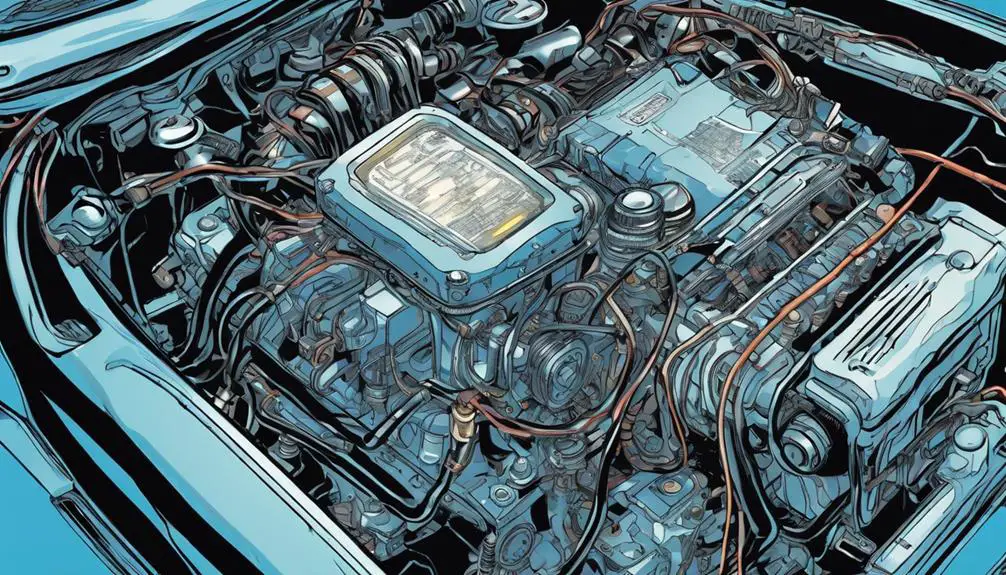
When you ride your motorcycle, software glitches in the ECU can cause unexpected throttle issues.
Keeping your ECU software updated is vital for peak performance, and knowing how to interpret diagnostic error codes can save you time and frustration.
Let's explore how these factors impact your ride.
ECU Software Updates
ECU software updates can resolve software glitches that affect throttle response in motorcycles. When the electronic control unit (ECU) runs outdated software, it can misinterpret your throttle inputs, resulting in sluggish acceleration or erratic performance. This can feel like a cage around your freedom, stifling your ride and dampening your spirit. Fortunately, updating your ECU's software can liberate you from this frustration.
You might wonder how to get these updates. Most manufacturers offer them through authorized dealerships or service centers. Don't hesitate to ask about the latest versions when you bring your bike in for maintenance. It's crucial to stay informed about any potential updates, as they often include fixes for known glitches and enhancements that improve your ride.
Once the update is complete, you should notice a smoother throttle response, allowing you to reclaim the thrill of the open road. So, embrace the liberation that comes with a well-functioning ECU. It's not just about fixing issues; it's about enhancing your overall riding experience and ensuring your bike performs at its best.
Don't let software glitches hold you back—take charge and update your ECU.
Diagnostic Error Codes
Diagnostic error codes can reveal software glitches in the ECU that disrupt your motorcycle's performance and throttle response. When you're feeling the thrill of the open road, the last thing you want is a hiccup in your throttle. These codes serve as critical signals, alerting you to underlying issues that could limit your ride's freedom.
You might notice abnormal behavior, like stalling or sluggish acceleration, and that's when checking the ECU becomes crucial. By connecting a diagnostic tool, you can pull those error codes and pinpoint the problem. Ignoring these codes can lead to bigger issues down the line, robbing you of the exhilarating experience you crave.
Once you've identified the code, explore the specifics. Each error has a meaning, giving you the power to tackle the glitch head-on. Sometimes, it could be a simple software update, while other times, it might require deeper investigation.
Don't let software glitches hold you back; take charge of your ride and guarantee your throttle responds like it's meant to. With the right knowledge, you can reclaim the joy of riding and break free from any constraints that disrupt your motorcycle's true potential.
Worn Throttle Components
Worn throttle components can greatly affect your motorcycle's performance and responsiveness. When you crank the throttle, you should feel an immediate surge of power and freedom. However, if components like the throttle cable, throttle body, or even the grip show wear, you might experience sluggishness or inconsistent acceleration. This can rob you of the exhilarating ride you crave.
Here are some signs to watch for:
- Sticky throttle: It doesn't return smoothly, making it hard to control.
- Unresponsive throttle: You twist it, but your bike doesn't respond as expected.
- Excessive play: You notice too much slack in the throttle grip.
Neglecting these worn components can lead to dangerous situations on the road. Regular inspections and timely replacements can restore that sense of liberation you feel when riding.
Don't let worn throttle components hold you back from the freedom of the open road. By staying proactive, you can guarantee your motorcycle remains a reliable companion in your quest for adventure.
Get in tune with your ride, and feel that connection with the asphalt beneath you!
Frequently Asked Questions
How Can I Improve My Motorcycle's Throttle Response?
To improve your motorcycle's throttle response, start by ensuring your throttle cables are properly adjusted and free of any obstructions.
Regularly clean the throttle body and air filter for peak airflow.
Check your fuel system for any blockages, and consider upgrading your ignition system for a better spark.
Finally, experimenting with different fuel types can also enhance performance.
Embrace the ride, and you'll feel the difference in how your bike responds!
What Maintenance Prevents Throttle Issues in Motorcycles?
Maintaining your motorcycle can feel like orchestrating a symphony of freedom!
To prevent throttle issues, regularly check and clean the throttle body, inspect the cables for wear, and guarantee the air filter's spotless.
It's essential to change the oil and fuel filters as recommended.
Don't forget to keep the battery charged; a strong battery is your motorcycle's heartbeat.
With consistent maintenance, you'll enjoy a smooth ride, releasing the road's potential!
Can Weather Affect Motorcycle Throttle Performance?
Absolutely, weather can affect your motorcycle's throttle performance.
When it's cold, the air density increases, which can lead to a richer fuel mixture and potential throttle response delays.
Wet conditions might cause moisture to interfere with electrical components, affecting responsiveness.
If you ride in extreme heat, overheating can cause the throttle to stick.
Keeping your bike maintained and adjusting your riding style to the weather can help you enjoy a smoother, freer ride.
Are Aftermarket Throttle Components Reliable?
When you're considering aftermarket throttle components, reliability often hinges on the brand and your specific bike model.
Many aftermarket parts can enhance performance, but they mightn't always meet OEM standards. It's essential to research and read reviews to guarantee you're investing in quality.
Remember, a well-chosen aftermarket part can offer greater freedom and control, but cutting corners might lead to issues.
Trust your instincts and prioritize parts that align with your riding style.
How Often Should I Inspect My Throttle System?
You should inspect your throttle system regularly to guarantee peak performance and safety. Aim for a thorough check every few months, or more frequently if you ride often or in challenging conditions.
Pay attention to any unusual responses when you twist the throttle. Staying proactive helps you catch potential issues early, so you can enjoy the freedom of the open road without worrying about your bike's reliability.
Trust your instincts and check often!
Conclusion
In summary, staying on top of common throttle issues can make a world of difference in your motorcycle's performance.
For instance, imagine you're cruising down a winding road, only to experience a sudden throttle response delay. Not only does it ruin the ride, but it can also lead to dangerous situations.
By addressing these issues early through regular maintenance, you can guarantee your motorcycle remains responsive and enjoyable, giving you peace of mind on every adventure.